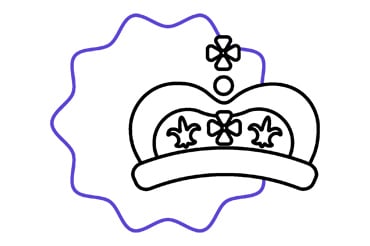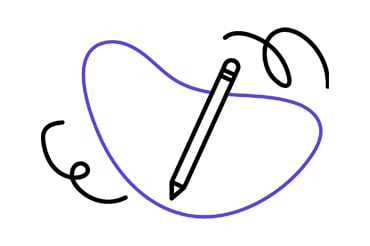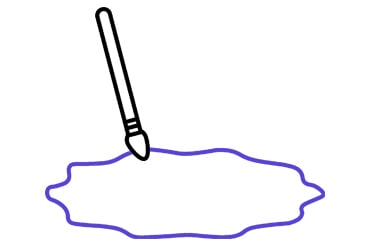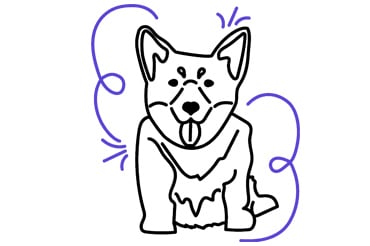What is a medal?

What is a medal?
A medal can mean many different things to many different people and I suppose the man on the street, (as I was before I started at the Royal Mint), thinks it’s an award that your Grandfather or Great Grandfather would wear upon their chest and is awarded it. Whereas medals now to me represent something far broader. More of an aide memoire to an event or person. More of an artistic expression piece in more modern times. That’s what I kind of think a medal is now. There is no doubt there are still service medals which hang on your chest but there is a whole world of medals out there that are for an event or a notion.
Do you think designing a medal gives you more creative freedom than a coin
It can do. The difference between the design for a coin and medal is that a coin has its very own anatomy which makes it very coin-like. Where you have got edge beading, so the little dots you have around the edge of a coin. You tend to see that a lot. You have to have everything very clearly defined because it has to convey important information very quickly so the denomination, what it is valued at, needs to be seen. And of course people who have problems with sight need to be able to identify what value of coin they actually have in their hand which is why they are shaped or of different sizes and thicknesses. Whereas a medal doesn’t live in that space. A medal does give you the freedom to express a little more. More your own hand is represented in the final piece. As opposed to a coin which is very clinical.
So what makes a good medal design
A good medal design is the conveying of an image in an engaging way so it makes you want to know more and get up close to the medal, spend some time with it, hold it in your hand. They’re a very tactile thing. I think for me, I think personally that’s what I like about a medal. It is something you want to pick up and hold in your hand and you do want to trace things with your fingers because generally you will see there is evidence of the artist at work on the piece. Not always, but I would say the majority of the time. I think an additional thing we should consider with medals is the levels of read and this is something we apply with coin design but also with medals. You get your first read, for example if you are doing a coin about a goldfish, the first thing you want to see is a goldfish but don’t leave it at that. Put in a separate read. Another piece of information, and see how many different levels of read you can fit into it. Because that keeps people looking at your piece of work and people like to figure them out as well. There’s like a little puzzle element to a design sometimes.
Like a designer could put messages in a design sometimes for example?
Yeah. Yeah. They can put an interesting fact that not many people know about the gold fish. Because we all know what a goldfish looks like but where does it live, where does it come from, where was the first goldfish found? You could put this information, not literally in there, but it may have come from the Galapagos Islands and you could put something of the Galapagos Islands in the background. So you’re tying these things up and when someone realises what they’ve just found that’s a nice engagement with the artist even though they are not there.

For designing the Jubilee medal are there any elements that you think would be particularly important?
Yeah. From personal experience I would be looking at the jubilee as a celebratory design. It would have to be positive as it’s a positive thing we are celebrating that 70 years have passed. And that’s a big deal isn’t it. We’ve made it another year and these are things we want to share with people except the queen is doing it on a larger scale obviously. With the designs I don’t want the designers to be too hemmed in.
So maybe you want people to think laterally about the Jubilee
How do they show celebration without a balloon or streamers? Think about elegance, think about something that’s vivacious. That might not be quite the right word but something that’s got life about it and vigour. That’s the word I’m looking for something that’s got life and vigour but is restrained in a way that you want to celebrate something that her majesty’s associated with. She’s not going to be there with an inflatable balloon but she could be there with maybe a rococo background. If you’re going to be designing for this competition I would be looking at those subtle things. Make it subtle, don’t try and ram it home with text. Text is always a get out of jail card. If you’re having to write what it is, that’s like a bad impression, you’re saying ‘I’m now going to do Tony Blair’. And it’s the same with design. If you start writing down what it is you’re trying to get across step back and start again.

Are there any rules about how much to put on a medal design? Is there such a thing as too busy?
I would look at people like Metcalfe, Percy Metcalf who’s the king of silhouettes. So silhouetting is, in modern parlance, I would say.. Look at Mickey Mouse. You know it’s Mickey Mouse. You don’t have to have the detail in there. He stands out. There’s no argument about what character you’re looking at. I can’t remember what the diameter is for this medal but I’m guessing it’s no more than 65mm which sounds a lot but it isn’t. Design with the design at size, so if you’re using a screen, if you design on an apple mac screen for example. Make sure you zoom your design down relative to the size that design of the final piece would be. And ask yourself the question: can I understand what I’m looking at? And that’s usually a good test. Keep testing it. I zoom in and out a lot when I’m designing because I want to make sure that the final piece is legible.
When you're designing do you ever ask other people for their help in stepping away from your design?
Yes. You have to be careful who you’re selecting. We do it in house. We’ve established a peer group review every day for the coins and medals where we share our work and share feedback which can be daunting because it’s your own personal work and you feel like you’re on judge. But it's very positive because it’s just a fresh pair of eyes. Nobody’s trying to take your design off you. Probably my best critic is my wife. I’ll show my wife my work if it’s a personal piece at home and I don’t always listen but acknowledge! I think that’s the best thing to do is share. Don’t put yourself in a corner with a design because there’s nothing better than having multiple views and it brings a bit more energy back to you as the designer. ‘Oh I never thought of it like that, or OK I’ll play with it a bit more.
When you get a design brief, for a medal or a coin, what’s the first thing you do? You don’t start drawing straight away do you?
Yeah. I don’t draw within a circle to start, I just draw out the things that immediately come into my head. So the stages are usually doodling at the start, then stepping back and doing the research. Because what you quickly find when you’re doodling, you might come up with fantastic compositions but then there’s no depth to your designs because you literally haven’t done the in-depth research to back it up. So I would always suggest that people doodle first. Importantly I don’t do it within a circle because what happens is you start designing to that shape. It doesn’t allow you then to move. You are almost like a director on a film set who is trying to find the right shot with the lens. The whole setup is in front of him already. He can just move his lens where he wants and that’s how I would tackle design. I doodle out first, then put the circles on top and think ‘oh yeah, that composition's working really well'. That’s possibly a good framework that I’ve established over the years. It works for me and seems to work with the team as well.

What do you find is the difference between designing a flat piece of work like a drawing and translating that for something that you know is going to be 3D? Are there any tips that you could give anyone who is going to be doing that for the first time?
Don’t overthink it. What can happen is that you start over thinking how this thing will be depicted in 3D space. Just get it down on paper first and then apply minimal shading just to let us know what the form is. I wouldn’t necessarily look at coins, I'd probably look at wedgewood because that’s more akin to paper. It’s white and I'd probably spend a good hour just looking at ceramics. You’ll see how ‘oh yeah, if I had to copy that in pencil that’s how it would look in real life as well'. Whereas a coin is metal and it’s shiny it has no fixed contrast. People can over think it and get stuck. But I’ve tried to find ways out of it for people and that’s why I’d suggest looking at sculpture, marble sculptures particularly because they give you a good sense of form. And that’s what you want to put into your medal. I would say make the most of that material and don't design flat. This isn’t a graphic design competition. Particularly with medals, graphic designs work better with coins because the message has to be really quick and direct. But on a medal, flat surfaces are just tedious because there’s no colour on them we’re not applying colour on this particular medal. You need to use the metal. Think about the ways the light would hit it.

What are the benefits of using metal for these things? Why use metal pieces to convey these ideas?
I think a metal medal would carry a certain weight and therefore a value. It would last a lot longer. They’d be easier to make because you can sand cast. Metal offers you things like toning. You can tone the metal to be red or brown or blue or green or however you want to do it. On a struck medal there will be no fixed contrast meaning that,
light can hit it at any point. I’m working with porcelain at the moment and that’s a very different material but we’re a mint and our speciality is striking pieces of metal and for that note I’d probably look at the coins in your pocket and see what attracts you to them. We all love sparkly bright things. Think of Christmas. What things work at Christmas. What decorations work at Christmas because they all have this little magpie factor built in. Not saying you have to have a disco ball of a design but understanding the way light gets trapped in certain areas and shadows get trapped in certain areas. One of the things we do quite a lot is add texture. Where someone is saying ‘look I need this area to be dark all the time, or darker. We’ll add sandpaper texture to that element which sets back the reflection of light a little. It can’t be bright if you're not allowing it to and that’s where we introduce contrast.
Is there anything else that you wanted to say? What do you think is important for people to know about the competition or about their designs or just about how they approach this?
Research. Research is the key thing and make it accessible to all. There’s a trip hazard in designing where you need to get a message across. I’ve done it. Everybody I know has done it. Which is that you get so into the subject you disappear down a rabbit hole and then the resulting design is so obtuse to the original brief that you might have got. ‘Oh I didn’t know that about the Queen, that she’s got three buttons on her cardi’ but how relevant is that? It’s not relevant at all. So it’s knowing when to stop research. It’s knowing when to go ‘Ok I know what I need to get through on this’ ‘ I need it to be jubilant’ ‘I need it to have some level of pomp and ceremony because we’re dealing with a royal event'. I would say look at the likes of Percy Metcalfe, Philip Nathan, Norman Sindell, Edward Dulac and his poetry medal .If you ever get the chance to see the real thing I’d advise you do so because he uses the minimal amount of material to achieve the form of the character. It’s one of my favourites, it really is. It’s so restrained.
